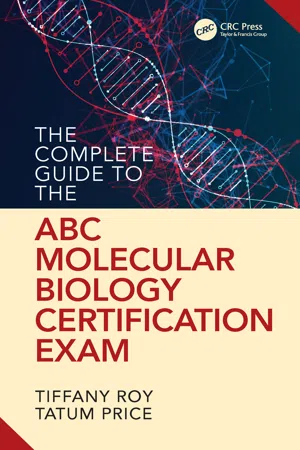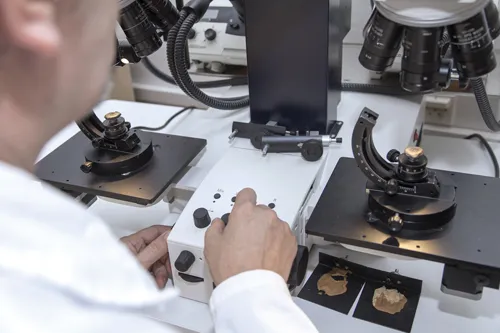
The Complete Guide to the ABC Molecular Biology Certification Exam
Tiffany Roy
- 226 páginas
- English
- ePUB (apto para móviles)
- Disponible en iOS y Android
The Complete Guide to the ABC Molecular Biology Certification Exam
Tiffany Roy
Información del libro
In 2009, the National Academy of Sciences (NAS) authored the report Strengthening Forensic Science in the United States: A Path Forward. In it, the Committee expressed the need for accreditation and certification. Accreditation, long recognized by public labs as an important benchmark in quality, was recognized as an important way to standardize laboratories that provide forensic services. Certification can play an important role as a method of oversight in the forensic sciences—something also recommended by the - National Commission on Forensic Science in October 2014.
The Complete Guide to the ABC's Molecular Biology is a professional certification examination preparation text for forensic scientists taking the American Board of Criminalistics Examination in Molecular Biology. The book serves as a resource for forensic scientists—who are facing more and more pressure to become certified—to support them in their pursuit of forensic certification.
In the years since the NAS report was published, there has been increased discussion of forensic certification requirements. ABC's Molecular Biology exam is a quality certification, and learning the concepts for it will invariably help any professional working in the field. The book prepares readers in all relevant topic areas, including: accreditation, safety, biological screen principles, anatomy and cell biology, crime scene and evidence handling, concepts in genetics, biochemistry, statistics, DNA evidence, and DNA testing.
The book will be particularly helpful for forensic science laboratory technicians, police and investigations professionals, forensic serology and DNA analysts, attorneys, and forensic science students. This study guide follows the guidelines for the exam and presents all the information necessary to prepare individuals to pass the exam.
Preguntas frecuentes
Información
1
General Knowledge Introduction
1.1 History
- Apply principles of general, cell and molecular biology, biochemistry, genetics, and statistics to the analysis of biological materials.
- Apply chemical, immunological, microscopic, and molecular biological methods in the assessment of unknown biological material.
- Apply specialized techniques to isolate and purify nucleic acids from various biological material.
- Apply specialized techniques to quantify DNA.
- Apply specialized techniques to develop profiles from the polymorphic regions in biological genomes.
- Apply principles of population genetics to then determine the significance of a polymorphic profile in the population.
- Stay abreast of current developments in the field of forensic biology.
- Recognize, collect, secure, and preserve physical evidence.
- Recognize the potential for forensic examinations in areas outside an area of specialization, prioritize the sequence of examinations, and handle evidence accordingly.
- Observe safe practices in the examination of biological evidence.
- Engage in impartial and ethical practices.
- Use and maintain laboratory instrumentation proficiently.
- Evaluate and interpret results of analyses.
- Thoroughly and accurately produce documentation to support results and conclusions.
- Effectively communicate scientific results through written reports.
- Provide sworn testimony regarding analytical methods, techniques, results, and conclusions.
- Employ quality assurance measures to ensure the integrity of the analyses.
- Understand and apply the validations for the introduction of new DNA technologies into the forensic laboratory.
- Be familiar with the documents Quality Assurance Standards for Forensic DNA Testing Laboratories and Quality Assurance Standards for Forensic Databasing Laboratories.
- Understand uses and practices of the Combined DNA Index System (CODIS).
- Conduct second reads and technical reviews of the analytical work of other forensic biologists.1
1.1.1 Significant Figures
Mathieu Orfila
Alphonse Bertillon

Hans Gross
Edmond Locard

Francis Galton
Leone Lattes
Calvin Goddard

Albert S. Osborn
Walter C. McCrone
August Vollmer
Paul L. Kirk
Karl Landsteiner
1.1.2 Evolution of the Practice
Índice
- Cover
- Half-Title
- Title
- Copyright
- Contents
- Purpose of This Book
- Authors
- 1 General Knowledge Introduction
- 2 Quality Assurance and Quality Control
- 3 Basic Legal and Scientific Concepts
- 4 Principles and Concepts of Biological Screening
- 5 Anatomy and Cell Biology
- 6 Concepts in Genetics, Biochemistry, and Statistics
- 7 Concepts in Genetics, Biochemistry, and Statistics cont.
- 8 History and Standards of DNA Evidence
- 9 DNA Testing Process Part 1
- 10 DNA Testing Process Part 2
- Index